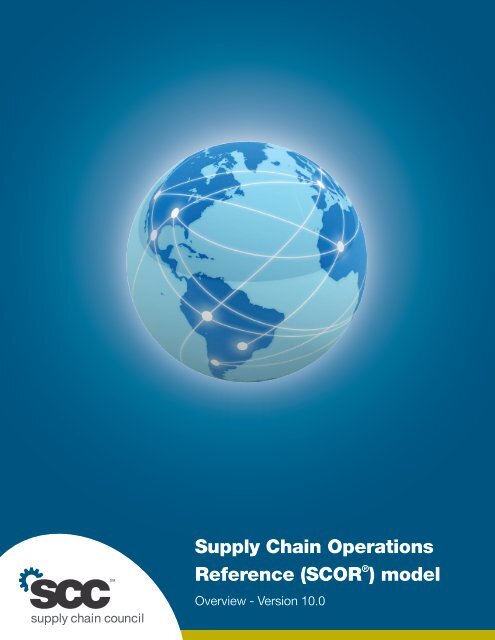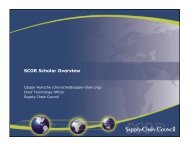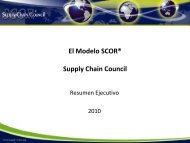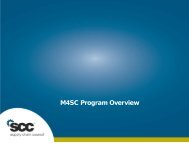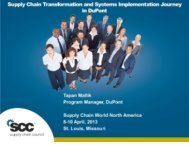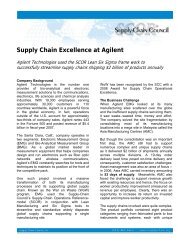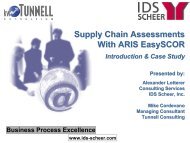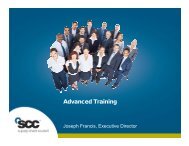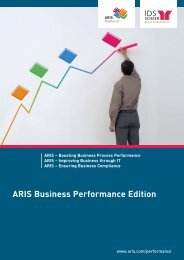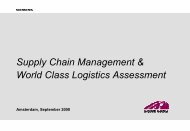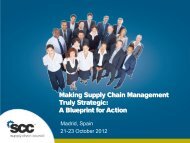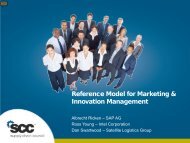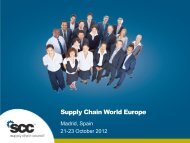SCOR Overview - Supply Chain Council
SCOR Overview - Supply Chain Council
SCOR Overview - Supply Chain Council
Create successful ePaper yourself
Turn your PDF publications into a flip-book with our unique Google optimized e-Paper software.
sccSM<br />
supply chain council<br />
<strong>Supply</strong> <strong>Chain</strong> Operations<br />
Reference (<strong>SCOR</strong> ® ) model<br />
<strong>Overview</strong> - Version 10.0
About <strong>Supply</strong> <strong>Chain</strong> <strong>Council</strong><br />
<strong>Supply</strong> <strong>Chain</strong> <strong>Council</strong> (SCC, supply-chain.org) is<br />
a global nonprofit organization whose framework,<br />
improvement methodology, and benchmarking tools<br />
help member organizations make dramatic and<br />
rapid improvements in supply chain performance.<br />
SCC established and maintains the supply chain<br />
world’s most widely accepted framework for<br />
evaluating and comparing supply chain activities<br />
and their performance: the <strong>Supply</strong> <strong>Chain</strong> Operations<br />
Reference (<strong>SCOR</strong> ® ) model. The <strong>SCOR</strong> framework<br />
makes it possible for organizations to quickly<br />
determine and compare the performance of supply<br />
chain and related operations within their organization<br />
and against other organizations. SCC and its<br />
member volunteers continually advance these tools<br />
and provide education on how to leverage them for<br />
achieving superior supply chain performance.<br />
A consortium of 69 organizations founded SCC<br />
in 1996. Today, the <strong>SCOR</strong> model is used by<br />
thousands of organizations worldwide. SCC<br />
membership is open to all organizations interested<br />
in applying and advancing the state-of-the-art in<br />
supply chain management systems and practices.<br />
Our members represent a broad cross-section of<br />
industries including manufacturers, distributors,<br />
retailers, and service providers as well as technology<br />
solution providers, business consultants, academic<br />
institutions, and government organizations. SCC has<br />
chapters in Australia/New Zealand, Greater China,<br />
Europe, Japan, Latin America, Middle East, North<br />
America, Southern Africa, and South East Asia.<br />
<strong>Supply</strong> <strong>Chain</strong> <strong>Council</strong>’s website contains additional<br />
information on the <strong>SCOR</strong> model, SCC membership,<br />
and other resources.<br />
www.supply-chain.org<br />
Join <strong>Supply</strong> <strong>Chain</strong> <strong>Council</strong><br />
SCC’s frameworks, network, benchmarking,<br />
research, and training help your management<br />
team analyze your supply chains faster, quickly<br />
recognize opportunities, implement changes,<br />
improve operational processes, track results, and<br />
sustain gains.<br />
SCC is an active, peer-led research organization<br />
with a keen focus on continuous research and<br />
development. Membership participation on<br />
committees and working groups contributes<br />
to the development of new models, tools, and<br />
practices that are released to the membership.<br />
Membership gives every supply chain<br />
professional within your organization access<br />
to the <strong>SCOR</strong> ® model, the Customer <strong>Chain</strong><br />
Operations Reference (CCOR SM ) model for<br />
customer chain management, and the Design<br />
<strong>Chain</strong> Operations Reference (DCOR SM ) model for<br />
design chain management.<br />
1<br />
We invite you to learn more and join us.<br />
- supply-chain.org/join<br />
- +1 202 962 0440<br />
supply-chain.org/scor
<strong>SCOR</strong> The Global <strong>Supply</strong> <strong>Chain</strong> Language<br />
The <strong>Supply</strong> <strong>Chain</strong> Operations Reference (<strong>SCOR</strong> ® )<br />
model provides a unique framework that links<br />
performance metrics, processes, best practices,<br />
and people into a unified structure. The framework<br />
supports communication between supply chain<br />
partners and enhances the effectiveness of supply<br />
chain management, technology, and related supply<br />
chain improvement activities.<br />
Organizational benefits of adopting the<br />
<strong>SCOR</strong> model include:<br />
• Rapid assessment of supply chain performance<br />
• Clear identification of performance gaps<br />
• Efficient supply chain network redesign and<br />
optimization<br />
• Enhanced operational control from standard core<br />
processes<br />
• Streamlined management reporting and<br />
organizational structure<br />
• Alignment of supply chain team skills with<br />
strategic objectives<br />
• A detailed game plan for launching new<br />
businesses and products<br />
• Systematic supply chain mergers that capture<br />
projected savings<br />
<strong>SCOR</strong> is a consensus<br />
model. It was developed<br />
and continues to evolve<br />
with the direct input<br />
of industry leaders<br />
who manage global supply chains and use it daily<br />
to analyze and improve the performance of their<br />
organizations. It features an intentionally broad<br />
scope and definitions that can be adapted to the<br />
specific supply chain requirements of any industry or<br />
application.<br />
2<br />
supply-chain.org/scor
Executive <strong>Overview</strong><br />
How <strong>SCOR</strong> Delivers Value<br />
As a business leader you are accountable to<br />
your customers, shareholders, and stakeholders.<br />
Business value, whether real or perceived, is<br />
derived from the predictability and sustainability of<br />
business outcomes. It lives, healthy or sick, in those<br />
gaps between expected vs. perceived vs. actual<br />
performance. Value is articulated by measuring what<br />
is being managed.<br />
The <strong>SCOR</strong> model helps refine strategy, define<br />
structure (including human capital), manage<br />
processes, and measure performance. An<br />
organization’s annual strategic priorities are manifest<br />
in <strong>SCOR</strong>’s vertical process integration (managementled<br />
programs for doing the right things, as defined by<br />
the customer) and its horizontal process integration<br />
(leadership-led programs for doing the right things<br />
well, as defined by capabilities).<br />
Organizations that have applied <strong>SCOR</strong> to help with<br />
supply chain problem solving, process improvement,<br />
process redesign, or business process engineering,<br />
have demonstrated that <strong>SCOR</strong> is an effective enabler<br />
for aligning an organization’s portfolio of improvement<br />
projects with strategic goals and objectives.<br />
<strong>SCOR</strong> Helps Solve the Top 5 <strong>Supply</strong><br />
<strong>Chain</strong> Challenges<br />
Economic cycles, whether markets are growing<br />
or contracting, always force organizations to take<br />
an intense look at their supply chains, question<br />
their assumptions, root out inefficiencies, and plan<br />
for growth. Such analysis and restructuring are<br />
an ongoing requirement for effective supply chain<br />
management. Here is a brief summary of how <strong>SCOR</strong><br />
aids this work and helps solve five of the neverending<br />
supply chain management challenges.<br />
<br />
<br />
Superior Customer Service<br />
Effective supply chain management is all<br />
about delivering the right product in the right<br />
quantity and in the right condition with the right<br />
documentation to the right place at the right<br />
time at the right price. If only it were as simple<br />
as it sounds.<br />
The <strong>SCOR</strong> model provides a framework for measuring<br />
and understanding current supply chain conditions and<br />
performance and creates a foundation for improvement.<br />
It can help supply chain managers evaluate cost/<br />
performance tradeoffs, develop strategies for meeting new<br />
customer expectations, and respond to domestic and<br />
global market growth.<br />
Cost Control<br />
<strong>Supply</strong> chain operating costs are under<br />
pressure from rising freight prices, global<br />
customers, technology upgrades, rising<br />
labor rates, expanding healthcare costs, new<br />
regulatory demands, and rising commodity<br />
prices. To control such costs there are<br />
thousands of potential metrics that supply chain<br />
organizations can and do measure. Managers<br />
need to zero in on the critical few that drive total<br />
supply chain costs within their organizations.<br />
<strong>SCOR</strong> metrics provide the basis for an organization to<br />
measure how successful it is in achieving its desired<br />
objectives. <strong>SCOR</strong> metrics are designed to be used in<br />
conjunction with supply chain performance attributes,<br />
making it easier to compare different supply chains and<br />
different supply chain strategies.<br />
3<br />
supply-chain.org/scor
Planning And Risk Management<br />
<strong>Supply</strong> chains must periodically be assessed<br />
and redesigned in response to market changes,<br />
including new product launches, global sourcing,<br />
new acquisitions, credit availability, the need<br />
to protect intellectual property, and the ability<br />
to maintain asset and shipment security. In<br />
addition, supply chain risks must be identified<br />
and quantified.<br />
Organizations in all sectors—commercial, military, and<br />
NGOs—have found that using <strong>SCOR</strong> as a planning and risk<br />
management foundation leads to faster implementation,<br />
more comprehensive identification of potential risks, and<br />
easier coordination with customers, suppliers, and other<br />
stakeholders. <strong>SCOR</strong> helps users establish rules and<br />
strategies, assign responsibilities, coordinate responses,<br />
and monitor current conditions.<br />
Supplier/Partner Relationship<br />
Management<br />
Different organizations, even different<br />
departments within the same organization,<br />
can have different methods for measuring and<br />
communicating performance expectations and<br />
results. Trust begins when managers let go of<br />
internal biases and make a conscious choice to<br />
follow mutually agreed upon standards in order<br />
to better understand current performance and<br />
opportunities for improvement.<br />
<br />
Talent<br />
As experienced supply chain managers<br />
retire—and organizations scale up to meet<br />
growing demand in developing markets—talent<br />
acquisition, training, and development are<br />
becoming increasingly important. <strong>Supply</strong> chain<br />
leaders need a thorough understanding of the<br />
key competencies required for supply chain<br />
management roles, specific job qualifications,<br />
methods for developing future talent and<br />
leaders, and the ability to efficiently source<br />
specific skills.<br />
Some SCC members have organized the capabilities of<br />
their global supply chain organizations around the <strong>SCOR</strong><br />
framework. The <strong>SCOR</strong> skills management framework<br />
complements process reference, metrics reference,<br />
and practice reference components with baseline skills,<br />
experience, aptitudes, and training.<br />
<strong>SCOR</strong> provides a common language for supply chain<br />
classification and analysis. Using a common language<br />
and framework makes it easier for teams to communicate,<br />
speeds benchmarking efforts, and enhances the evaluation<br />
of best practices.<br />
4<br />
supply-chain.org/scor
Achieving: <strong>Supply</strong> <strong>Chain</strong> Superiority<br />
<strong>SCOR</strong> is about much more than individual<br />
improvement projects. The ultimate objective of any<br />
organization that deploys the <strong>SCOR</strong> model is to build<br />
a superior supply chain that is integrated with the<br />
overall organizational strategy. Aided by common<br />
supply chain definitions, metrics, and strategies,<br />
the integrated supply chain extends between and<br />
beyond the walls of the organization that owns the<br />
customer order.<br />
You know that you can’t manage what you can’t<br />
measure. Well, it’s also impossible to make effective<br />
decisions if every department in your organization<br />
measures performance differently. Organizations<br />
that are not integrated—where planning, sourcing,<br />
manufacturing, and logistics all have their own<br />
agendas and their own performance metrics<br />
that do not align with overall business goals—<br />
cannot respond effectively to market changes and<br />
opportunities. An integrated operating model does<br />
not happen spontaneously. The natural tendency<br />
is toward expediency and whatever set of metrics<br />
makes each department or functional area look best.<br />
SCC research has found a high correlation between<br />
organizations that implement an integrated, end-toend<br />
supply chain operating model enabled by the<br />
<strong>SCOR</strong> model and market outperformance in key<br />
financial measures. These include profit margins,<br />
inventory turns, asset turnover, and working capital.<br />
In addition, such organizations benefit from a much<br />
lower risk of supply chain disruption.<br />
How <strong>SCOR</strong> Works:<br />
It’s All About Relationships<br />
The <strong>SCOR</strong> model provides a framework that links<br />
business processes, metrics, best practices, and<br />
technology into a unified structure. It is hierarchical in<br />
nature, interactive, and interlinked. The <strong>SCOR</strong> model<br />
supports supply chain improvement by aiding the<br />
capture of an “as-is” current state from which the<br />
desired “to-be” future state can be derived.<br />
By speeding data collection, <strong>SCOR</strong> can make it<br />
much less time consuming for managers to find<br />
answers to basic questions about how a supply<br />
chain is performing, drill down to identify contributing<br />
factors, and quickly initiate corrective actions. <strong>SCOR</strong><br />
facilitates supply chain integration by providing<br />
common process and metric definitions applicable<br />
across multiple organizations. For each process it<br />
includes parent and/or child processes, performance<br />
metrics, best practices, and the skills required for the<br />
employees performing the process.<br />
For example, consider Perfect Order Fulfillment.<br />
This metric provides a good indication of how well<br />
every facet of a supply chain—planning, sourcing,<br />
manufacturing, and delivery—are tuned and<br />
coordinated to meet customer demand. Achieving<br />
Perfect Order Fulfillment of 100% is difficult, if not<br />
impossible, and may be prohibitively expensive<br />
because it has so many contributing factors. These<br />
include: on time to customer request, complete order<br />
shipment, undamaged, and the correct paperwork.<br />
The <strong>SCOR</strong> model contains the Perfect Order<br />
Fulfillment metric definition, calculation methods,<br />
and discussion points. The <strong>SCOR</strong> model lists the<br />
processes that influence the performance of the<br />
level 1 metric and the associated level 2 metrics to<br />
analyze in order to identify the root causes of any<br />
issue. By examining level 2 metrics, managers can<br />
then determine the level 3 processes and metrics to<br />
investigate.<br />
5<br />
supply-chain.org/scor
The <strong>SCOR</strong> Structure<br />
The Boundaries of Any Model Must be Well Defined<br />
PLAN PLAN PLAN<br />
DELIVER<br />
SOURCE<br />
MAKE DELIVER SOURCE MAKE DELIVER SOURCE MAKE DELIVER SOURCE<br />
RETURN<br />
RETURN<br />
RETURN<br />
RETURN<br />
RETURN<br />
RETURN<br />
RETURN<br />
RETURN<br />
Supplier’s<br />
Supplier<br />
SUPPLIER<br />
Internal or External<br />
YOUR ORGANIZATION<br />
CUSTOMER<br />
Internal or External<br />
Customer’s<br />
Customer<br />
<strong>SCOR</strong> processes extend from your supplier’s<br />
supplier to your customer’s customer. This<br />
includes all customer interactions from order entry<br />
through paid invoice; all product (physical material<br />
and service) transactions, including equipment,<br />
supplies, spare parts, software, etc.; and all market<br />
interactions, from understanding aggregate demand<br />
to the fulfillment of each order.<br />
<strong>SCOR</strong> does not describe every business process<br />
or activity. It does not address sales and marketing,<br />
research and technology development, or product<br />
development. <strong>SCOR</strong> assumes but does not<br />
specifically address quality, information technology,<br />
or administration.<br />
What is a Process Reference Model<br />
The purpose of a process reference model, or<br />
business process framework, is the ability to<br />
describe your process architecture in a way that<br />
makes sense to key business partners. It is especially<br />
useful for describing value chains that cut across<br />
multiple departments and organizations, providing a<br />
common language for managing such processes.<br />
A process reference model can be a powerful<br />
management tool. Once a complex management<br />
process is captured in standard process reference<br />
model form, it can be measured, managed, and<br />
controlled. It can also be tuned and re-tuned to<br />
achieve a specific purpose or attain a competitive<br />
advantage.<br />
The <strong>SCOR</strong> process reference model<br />
contains:<br />
• Performance Metrics: Standard metrics to<br />
measure process performance<br />
• Processes: Standard descriptions of<br />
management processes and a framework of<br />
process relationships<br />
• Practices: Management practices that produce<br />
best-in-class performance<br />
• People: Training and skills requirements aligned<br />
with processes, best practices, and metrics<br />
6<br />
supply-chain.org/scor
<strong>SCOR</strong> Performance<br />
The performance section of <strong>SCOR</strong> consists of two types of elements: Performance Attributes and Metrics. <strong>SCOR</strong><br />
Level 1 metrics are strategic, high-level measures that cross multiple <strong>SCOR</strong> processes. Lower level metrics are<br />
associated with a narrower subset of processes. For example, delivery performance is calculated as the total<br />
number of products delivered on time and in full based on a commit date.<br />
Performance Attributes<br />
A performance attribute is a group of metrics used to express a strategy. An attribute itself cannot be measured; it<br />
is used to set strategic direction. For example, “The LX product needs to be best-in-class for reliability,” and “The<br />
XY market requires us to be among the top five most agile manufacturers.” Metrics measure the ability of a supply<br />
chain to achieve these strategic attributes.<br />
<strong>SCOR</strong> identifies five core supply chain performance attributes: Reliability, Responsiveness, Agility, Costs,<br />
and Asset Management. Consideration of these attributes makes it possible to compare an organization that<br />
strategically chooses to be the low-cost provider against an organization that chooses to compete on reliability<br />
and performance.<br />
Reliability<br />
The Reliability attribute addresses the ability to perform tasks as expected. Reliability focuses on<br />
the predictability of the outcome of a process. Typical metrics for the reliability attribute include:<br />
on-time, the right quantity, the right quality. The <strong>SCOR</strong> KPI (level 1 metric) is Perfect Order<br />
Fulfillment. Reliability is a customer-focused attribute.<br />
Responsiveness<br />
The Responsiveness attribute describes the speed at which tasks are performed. Examples<br />
include cycle-time metrics. The <strong>SCOR</strong> KPI is Order Fulfillment Cycle Time. Responsiveness is<br />
a customer-focused attribute.<br />
Agility<br />
The Agility attribute describes the ability to respond to external influences and the ability to<br />
change. External influences include: Non-forecasted increases or decreases in demand;<br />
suppliers or partners going out of business; natural disasters; acts of (cyber) terrorism;<br />
availability of financial tools (the economy); or labor issues. The <strong>SCOR</strong> KPIs include Flexibility<br />
and Adaptability. Agility is a customer-focused attribute.<br />
Costs<br />
Assets<br />
The Cost attribute describes the cost of operating the process. It includes labor costs, material<br />
costs, and transportation costs. The <strong>SCOR</strong> KPIs include Cost of Goods Sold and <strong>Supply</strong> <strong>Chain</strong><br />
Management Cost. These two indicators cover all supply chain spend. Cost is an internallyfocused<br />
attribute.<br />
The Asset Management Efficiency (“Assets”) attribute describes the ability to efficiently utilize<br />
assets. Asset management strategies in a supply chain include inventory reduction and<br />
in-sourcing vs. outsourcing. Metrics include: inventory days of supply and capacity utilization.<br />
The <strong>SCOR</strong> KPIs include: Cash-to-Cash Cycle Time and Return on Fixed Assets. Asset<br />
Management Efficiency is an internally-focused attribute.<br />
7<br />
supply-chain.org/scor
Metrics<br />
A metric is a standard for measurement of the performance of a process. <strong>SCOR</strong> metrics are diagnostic metrics.<br />
<strong>SCOR</strong> recognizes three levels of predefined metrics:<br />
• Level 1 metrics are diagnostics for the overall health of the supply chain. These metrics are also known as<br />
strategic metrics and key performance indicators (KPIs). Benchmarking level 1 metrics helps establish realistic<br />
targets that support strategic objectives.<br />
• Level 2 metrics serve as diagnostics for the level 1 metrics. The diagnostic relationship helps to identify the<br />
root cause or causes of a performance gap for a level 1 metric.<br />
• Level 3 metrics serve as diagnostics for level 2 metrics.<br />
The analysis of performance of metrics from level 1 through 3 is referred to as decomposition. Decomposition<br />
helps identify the processes that need to be studied further. (Processes are linked to level 1 and level 2 metrics.)<br />
Many metrics in the <strong>SCOR</strong> model are hierarchical, just as the process elements are hierarchical. Level 1 metrics<br />
are created from lower level calculations. Level 2 metrics are generally associated with a narrower subset of<br />
processes. For example, Delivery Performance is calculated as the total number of products delivered on time and<br />
in full based on a commit date. Additionally, metrics (diagnostics) are used to diagnose variations in performance<br />
against plan. For example, an organization may wish to examine the correlation between the request date and<br />
commit date.<br />
<strong>Supply</strong> <strong>Chain</strong> <strong>Council</strong> recommends that supply chain scorecards contain at least one metric for each performance<br />
attribute to ensure balanced decision making and governance.<br />
Benchmarking: Get More Out of <strong>SCOR</strong><br />
<strong>SCOR</strong>mark SM benchmarking supports and integrates seamlessly<br />
into the analyze phase of applying the <strong>SCOR</strong> model. It provides a<br />
benchmark report that highlights where an organization stands against<br />
selected peer groups. Our members use <strong>SCOR</strong>mark to set reasonable<br />
performance goals, calculate performance gaps against a global<br />
database, and develop organization-specific roadmaps for supply chain<br />
competitive success.<br />
Visit supply-chain.org/scormark to learn more.<br />
8<br />
supply-chain.org/scor
<strong>SCOR</strong> Metrics<br />
<strong>Supply</strong> <strong>Chain</strong> Reliability <strong>Supply</strong> <strong>Chain</strong> Responsiveness <strong>Supply</strong> <strong>Chain</strong> Agility <strong>Supply</strong> <strong>Chain</strong> Costs<br />
RL.1.1 - Perfect Order Fulfillment<br />
RS.1.1 - Order Fulfillment Cycle Time<br />
AG.1.1 - Upside <strong>Supply</strong> <strong>Chain</strong> Flexibility<br />
CO.1.1 - <strong>Supply</strong> <strong>Chain</strong> Man<br />
RL.2.1 - % of Orders Delivered In Full<br />
RS.2.1 - Source Cycle Time<br />
AG.2.1 - Upside Flexibility (Source)<br />
CO.2.1 - Cost to Plan<br />
RL.3.33 - Delivery Item Accuracy<br />
RL.3.35 - Delivery Quantity Accuracy<br />
RS.3.8 - Authorize Supplier Payment Cycle Time<br />
RS.3.35 - Identify Sources of <strong>Supply</strong> Cycle Time<br />
AG.2.2 - Upside Flexibility (Make)<br />
CO.3.104 - Cost to Plan (Deliver)<br />
CO.3.105 - Cost to Plan (Make)<br />
RL.2.2 - Delivery Performance to<br />
Customer Commit Date<br />
RL.3.32 - Customer Commit Date Achievement Time<br />
Customer Receiving<br />
RL.3.34 - Delivery Location Accuracy<br />
RL.2.3 - Documentation Accuracy<br />
RL.3.31 - Compliance Documentation Accuracy<br />
RL.3.43 - Other Required Documentation Accuracy<br />
RL.3.45 - Payment Documentation Accuracy<br />
RL.3.50 - Shipping Documentation Accuracy<br />
RL.2.4 - Perfect Condition<br />
RL.3.12 - % Of Faultless Installations<br />
RL.3.24 - % Orders/Lines Received Damage Free<br />
RL.3.41 - Orders Delivered Damage Free Conformance<br />
RL.3.42 - Orders Delivered Defect Free Conformance<br />
RL.3.55 - Warranty and Returns<br />
RS.3.107 - Receive Product Cycle Time<br />
RS.3.122 - Schedule Product Deliveries Cycle Time<br />
RS.3.125 - Select Supplier and Negotiate Cycle Time<br />
RS.3.139 - Transfer Product Cycle Time<br />
RS.3.140 - Verify Product Cycle Time<br />
RS.2.2 - Make Cycle Time<br />
RS.3.33 - Finalize Production Engineering Cycle Time<br />
RS.3.49 - Issue Material Cycle Time<br />
RS.3.101 - Produce and Test Cycle Time<br />
RS.3.114 - Release Finished Product to Deliver Cycle Time<br />
RS.3.123 - Schedule Production Activities Cycle Time<br />
RS.3.128 - Stage Finished Product Cycle Time<br />
RS.3.142 - Package Cycle Time<br />
RS.2.3 - Deliver Cycle Time<br />
RS.3.16 - Build Loads Cycle Time<br />
RS.3.18 - Consolidate Orders Cycle Time<br />
RS.3.46 - Install Product Cycle Time<br />
RS.3.51 - Load Product & Generate Shipping<br />
Documentation Cycle Time<br />
RS.3.95 - Pack Product Cycle Time<br />
RS.3.96 - Pick Product Cycle Time<br />
RS.3.102 - Receive & Verify Product by Customer Cycle Time<br />
RS.3.110 - Receive Product from Source or Make Cycle Time<br />
RS.3.111 - Receive, Configure, Enter, & Validate Order<br />
Cycle Time<br />
RS.3.116 - Reserve Resources and Determine Delivery<br />
Date Cycle Time<br />
RS.3.117 - Route Shipments Cycle Time<br />
AG.2.3 - Upside Flexibility (Deliver)<br />
AG.2.4 - Upside Return Flexibility (Source)<br />
AG.2.5 - Upside Return Flexibility (Deliver)<br />
AG.1.2 - Upside <strong>Supply</strong> <strong>Chain</strong> Adaptability<br />
AG.2.6 - Upside Adaptability (Source)<br />
AG.2.7 - Upside Adaptability (Make)<br />
AG.2.8 - Upside Adaptability (Deliver)<br />
AG.2.9 - Upside Return Adaptability (Source)<br />
AG.2.10 - Upside Return Adaptability (Deliver)<br />
AG.1.3 - Downside <strong>Supply</strong> <strong>Chain</strong> Adaptability<br />
AG.2.11 - Downside Adaptability (Source)<br />
AG.2.12 - Downside Adaptability (Make)<br />
AG.2.13 - Downside Adaptability (Deliver)<br />
AG.1.4 - Overall Value at Risk (VAR)<br />
AG.2.14 - Supplier's/Customer's/<br />
Product's Risk Rating<br />
AG.2.15 - Value at Risk (Plan)<br />
AG.2.16 - Value at Risk (Source)<br />
CO.3.106 - Cost to Plan (Return)<br />
CO.3.107 - Cost to Plan (Source)<br />
CO.3.108 - Cost to Plan <strong>Supply</strong> C<br />
CO.2.2 - Cost to Source<br />
CO.3.27 - Cost to Authorize Supp<br />
Payment<br />
CO.3.115 - Cost to Receive Produ<br />
CO.3.126 - Cost to Schedule Prod<br />
Deliveries<br />
CO.3.137 - Cost to Transfer Produ<br />
CO.3.138 - Cost to Verify Product<br />
CO.2.3 - Cost to Make<br />
CO.2.4 - Cost to Deliver<br />
CO.3.163 - Order Management C<br />
CO.3.200 - Order Delivery Costs<br />
CO.2.5 - Cost to Return<br />
CO.3.131 - Cost to Source Return<br />
CO.2.7 - Mitigation Cost ($)<br />
CO.3.178 - Risk Mitigation Costs<br />
CO.3.179 - Risk Mitigation Costs<br />
CO.3.180 - Risk Mitigation Costs<br />
CO.3.181 - Risk Mitigation Costs<br />
CO.3.182 - Risk Mitigation Costs<br />
CO.1.2 - Cost of Goods Sol<br />
CO.3.140 - Direct Labor Co<br />
RS.3.120 - Schedule Installation Cycle Time<br />
AG.2.17 - Value at Risk (Make)<br />
CO.3.141 - Direct Material C<br />
RS.3.124 - Select Carriers & Rate Shipments Cycle Time<br />
RS.3.126 - Ship Product Cycle Time<br />
AG.2.18 - Value at Risk (Deliver)<br />
CO.3.155 - Indirect Cost Re<br />
to Production<br />
RS.2.4 - Delivery Retail Cycle Time<br />
AG.2.19 - Value at Risk (Return)<br />
RS.3.17 - Checkout Cycle Time<br />
RS.3.32 - Fill Shopping Cart Cycle Time<br />
RS.3.34 - Generate Stocking Schedule Cycle Time<br />
RS.3.97 - Pick Product from Backroom Cycle Time<br />
RS.3.109 - Receive Product at Store Cycle Time<br />
RS.3.129 - Stock Shelf Cycle Time<br />
9<br />
supply-chain.org/scor
<strong>Supply</strong> <strong>Chain</strong> Costs<br />
<strong>Supply</strong> <strong>Chain</strong> Asset Management<br />
e)<br />
r)<br />
ty<br />
rce)<br />
liver)<br />
bility<br />
)<br />
)<br />
CO.1.1 - <strong>Supply</strong> <strong>Chain</strong> Management Cost<br />
CO.2.1 - Cost to Plan<br />
CO.3.104 - Cost to Plan (Deliver)<br />
CO.3.105 - Cost to Plan (Make)<br />
CO.3.106 - Cost to Plan (Return)<br />
CO.3.107 - Cost to Plan (Source)<br />
CO.3.108 - Cost to Plan <strong>Supply</strong> <strong>Chain</strong><br />
CO.2.2 - Cost to Source<br />
CO.3.27 - Cost to Authorize Supplier<br />
Payment<br />
CO.3.115 - Cost to Receive Product<br />
CO.3.126 - Cost to Schedule Product<br />
Deliveries<br />
CO.3.137 - Cost to Transfer Product<br />
CO.3.138 - Cost to Verify Product<br />
CO.2.3 - Cost to Make<br />
CO.2.4 - Cost to Deliver<br />
CO.3.163 - Order Management Costs<br />
CO.3.200 - Order Delivery Costs<br />
CO.2.5 - Cost to Return<br />
CO.3.131 - Cost to Source Return<br />
CO.2.7 - Mitigation Cost ($)<br />
CO.3.178 - Risk Mitigation Costs (Deliver)<br />
CO.3.179 - Risk Mitigation Costs (Make)<br />
CO.3.180 - Risk Mitigation Costs (Plan)<br />
CO.3.181 - Risk Mitigation Costs (Return)<br />
CO.3.182 - Risk Mitigation Costs (Source)<br />
AM.1.1 - Cash-to-Cash Cycle Time<br />
AM.2.1 - Days Sales Outstanding<br />
AM.2.2 - Inventory Days of <strong>Supply</strong><br />
AM.3.45 - Inventory Days of <strong>Supply</strong><br />
( Finished Goods )<br />
AM.3.16 - Inventory Days of <strong>Supply</strong><br />
( Raw Material )<br />
AM.3.17 - Inventory Days of <strong>Supply</strong> ( WIP )<br />
AM.3.23 - Recycle Days of <strong>Supply</strong><br />
AM.3.28 - Percentage Defective Inventory<br />
AM.3.37 - Percentage Excess Inventory<br />
AM.3.44 - Percentage Unserviceable<br />
MRO Inventory<br />
AM.2.3 - Days Payable Outstanding<br />
AM.1.2 - Return on <strong>Supply</strong> <strong>Chain</strong><br />
Fixed Assets<br />
AM.2.5 - <strong>Supply</strong> <strong>Chain</strong> Fixed Assets<br />
AM.3.11 - Fixed Asset Value (Deliver)<br />
AM.3.18 - Fixed Asset Value (Make)<br />
AM.3.20 - Fixed Asset Value (Plan)<br />
AM.3.24 - Fixed Asset Value (Return)<br />
AM.3.27 - Fixed Asset Value (Source)<br />
AM.1.3 - Return on Working<br />
Capital<br />
AM.2.6 - Accounts Payable<br />
(Payables Outstanding)<br />
AM.2.7 - Accounts Receivable<br />
(Sales Outstanding)<br />
CO.1.2 - Cost of Goods Sold<br />
CO.3.140 - Direct Labor Cost<br />
AM.2.8 - Inventory<br />
CO.3.141 - Direct Material Cost<br />
CO.3.155 - Indirect Cost Related<br />
to Production<br />
10<br />
supply-chain.org/scor
<strong>SCOR</strong> Processes<br />
<strong>SCOR</strong> identifies the unique processes a supply chain requires to support the objective of fulfilling customer<br />
orders. By definition, a process is a unique activity performed to meet predefined outcomes.<br />
Similar to nesting Russian matryoshka dolls, <strong>SCOR</strong> processes are organized by aggregation and<br />
decomposition relationships. From level 3 to 2 to 1 is aggregation; from 1 to 2 to 3 is decomposition.<br />
<strong>SCOR</strong> processes help standardize the description of the supply chain architecture (level 1 and level 2<br />
processes) and the implementation of the architecture (level 3 processes). <strong>SCOR</strong> provides standards<br />
down to the level where process descriptions are applicable across a range of industries. Further detail is<br />
industry and organization specific (level 4 and below).<br />
<strong>SCOR</strong> Contains Three Levels of Process Detail<br />
In Scope<br />
Applicable Across Industries<br />
Not in Scope<br />
Industry Specific<br />
Level Application Examples<br />
<br />
<br />
<br />
<br />
Level 1 processes are used to describe the scope and<br />
high level configuration of a supply chain. <strong>SCOR</strong> has<br />
five level 1 processes.<br />
Level 2 processes differentiate the strategies of the level<br />
1 processes. Both the level 2 processes themselves as<br />
well as their positioning in the supply chain determine<br />
the supply chain strategy. <strong>SCOR</strong> contains 26 level 2<br />
processes.<br />
Level 3 processes describe the steps performed to<br />
execute the level 2 processes. The sequence in which<br />
these processes are executed influences the performance<br />
of the level 2 processes and the overall supply<br />
chain. <strong>SCOR</strong> contains 185 level 3 processes.<br />
Level 4 processes describe the industry specific activities<br />
required to perform level 3 processes. Level 4<br />
processes describe the detailed implementation of a<br />
process. <strong>SCOR</strong> does not detail level 4 processes.<br />
Organizations and industries develop their own level 4<br />
processes.<br />
Plan, Source, Make, Deliver, and<br />
Return<br />
Example Make level 2 processes:<br />
› Make-to-Stock<br />
› Make-to-Order<br />
› Engineer-to-Order<br />
Example Make-to-Order level 3<br />
processes:<br />
› Schedule Production Activities<br />
› Issue Product<br />
› Produce and Test<br />
› Package<br />
› Stage<br />
› Dispose Waste<br />
› Release Product<br />
Example Issue Product level 4<br />
processes for the electronics<br />
industry:<br />
› Print Pick List<br />
› Pick Items (Bin)<br />
› Deliver Bin to Production Cell<br />
› Return Empty Bins to Pick Area<br />
› Close Pick Order<br />
11<br />
supply-chain.org/scor
<strong>SCOR</strong> Is Based on Five Level 1 Management Processes<br />
Plan (P)<br />
The Plan processes describe the planning activities associated with operating a supply chain. This<br />
includes gathering customer requirements, collecting information on available resources, and balancing<br />
requirements and resources to determine planned capabilities and resource gaps. This is followed by<br />
identifying the actions required to correct any gaps.<br />
Source (S)<br />
The Source processes describe the ordering (or scheduling) and receipt of goods and services. The<br />
Source process includes issuing purchase orders, scheduling deliveries, receiving, shipment validation and<br />
storage, and accepting supplier invoices.<br />
Make (M)<br />
The Make processes describe the activities associated with the conversion of materials or creation of<br />
the content for services. It focuses on conversion of materials rather than production or manufacturing<br />
because Make represents all types of material conversions: assembly, chemical processing, maintenance,<br />
repair, overhaul, recycling, refurbishment, remanufacturing, and other material conversion processes. As a<br />
general guideline: these processes are recognized by the fact that one or more item numbers go in, and<br />
one or more different item numbers come out of this process.<br />
Deliver (D)<br />
The Deliver processes describe the activities associated with the creation, maintenance, and fulfillment<br />
of customer orders. It includes the receipt, validation, and creation of customer orders; scheduling order<br />
delivery; pick, pack, and shipment; and invoicing the customer.<br />
Return (R)<br />
The Return processes describe the activities associated with the reverse flow of goods back from the<br />
customer. The Return process includes the identification of the need for a return, the disposition decision<br />
making, the scheduling of the return, and the shipment and receipt of the returned goods. (Repair,<br />
recycling, refurbishment, and remanufacturing processes are not described using Return process<br />
elements. See Make.)<br />
12<br />
supply-chain.org/scor
<strong>SCOR</strong> Processes<br />
Each Level 2 Process Can Be Further Described by Type<br />
Planning<br />
A process that aligns expected resources to meet expected demand requirements.<br />
Planning processes:<br />
› Balance aggregated demand and supply<br />
› Generally occur at regular, periodic intervals<br />
› Consider consistent planning horizon<br />
› Can contribute to supply chain response time<br />
Execution<br />
A process triggered by planned or actual demand that changes the state of material goods.<br />
Execution processes:<br />
› Generally involve:<br />
1. Scheduling/sequencing,<br />
2. Transforming product, and/or<br />
3. Moving product to the next process.<br />
› Can contribute to the order fulfillment cycle time<br />
Enable<br />
A process that prepares, maintains, or manages information or relationships on which<br />
planning and execution processes rely.<br />
Each Execution process, for example, has three different possible capabilities of representing and<br />
responding to customer orders. Different supply chain strategy supports corresponding product or service<br />
types. These categories also affect Plan and Return processes.<br />
Stocked Product (S1, M1, D1, D4)<br />
• Inventory driven (Plan)<br />
• Standard material orders<br />
• High fill rate, short turnaround<br />
Make-to-Order (S2, M2, D2)<br />
• Customer order driven<br />
• Configurable materials<br />
• Longer turn-around times<br />
Engineer-to-Order (S3, M3, D3)<br />
• Customer requirements driven<br />
• Sourcing new materials<br />
• Longest long lead-times, low fill rates<br />
13<br />
supply-chain.org/scor
<strong>SCOR</strong> Process Detailed Example<br />
sD1.2 Receive, Enter, and Validate Order<br />
Definition: Receive orders from the customer and enter them into a an organization’s order processing system.<br />
Orders can be received through phone, fax, or electronic media. Technically examine orders to ensure an<br />
orderable configuration and provide accurate prices. Check the customer’s credit. Optionally accept payment.<br />
<strong>SCOR</strong> is available online in a searchable HTML format for all SCC member organizations. Visit supply-chain.org/<br />
online-access to access in HTML, download a PDF format, or order a print edition.<br />
<strong>SCOR</strong> Online Access Screenshot<br />
14<br />
supply-chain.org/scor
<strong>SCOR</strong> Process Model<br />
sP PLAN<br />
sS SOURCE<br />
sM MAKE<br />
sP1 Plan<br />
<strong>Supply</strong> <strong>Chain</strong><br />
sP2<br />
Plan Source<br />
sP3<br />
Plan Make<br />
sP4<br />
Plan Deliver<br />
sP5<br />
Plan Return<br />
sS1 Source<br />
Stocked<br />
Product<br />
sS2 Source<br />
Make-to-Order<br />
Product<br />
sS3 Source<br />
Engineer-to-<br />
Order Product<br />
sM1 Make-to-<br />
Stock<br />
sM2 Maketo-Order<br />
sM<br />
Eng<br />
Ord<br />
sP1.1:<br />
Identify, Prioritize,<br />
and Aggregate<br />
<strong>Supply</strong> <strong>Chain</strong><br />
Requirements<br />
sP1.2:<br />
Identify, Prioritize,<br />
and Aggregate<br />
<strong>Supply</strong> <strong>Chain</strong><br />
Resources<br />
sP1.3:<br />
Balance <strong>Supply</strong><br />
<strong>Chain</strong> Resources<br />
with <strong>Supply</strong><br />
<strong>Chain</strong> Requirements<br />
sP1.4:<br />
Establish and<br />
Communicate<br />
<strong>Supply</strong> <strong>Chain</strong><br />
Plans<br />
sP2.1:<br />
Identify,<br />
Prioritize, and<br />
Aggregate<br />
Product<br />
Requirements<br />
sP2.2:<br />
Identify, Assess,<br />
and Aggregate<br />
Product<br />
Resources<br />
sP2.3:<br />
Balance Product<br />
Resources with<br />
Product<br />
Requirements<br />
sP2.4:<br />
Establish<br />
Sourcing Plans<br />
sP3.1:<br />
Identify,<br />
Prioritize, and<br />
Aggregate<br />
Production<br />
Requirements<br />
sP3.2:<br />
Identify, Assess,<br />
and Aggregate<br />
Production<br />
Resources<br />
sP3.3:<br />
Balance<br />
Production<br />
Resources with<br />
Production<br />
Requirements<br />
sP3.4:<br />
Establish<br />
Production<br />
Plans<br />
sP4.1:<br />
Identify,<br />
Prioritize, and<br />
Aggregate<br />
Delivery<br />
Requirements<br />
sP4.2:<br />
Identify, Assess,<br />
and Aggregate<br />
Delivery<br />
Resources<br />
sP4.3:<br />
Balance Delivery<br />
Resources with<br />
Delivery<br />
Requirements<br />
sP4.4:<br />
Establish<br />
Delivery Plans<br />
sP5.1:<br />
Identify,<br />
Prioritize, and<br />
Aggregate<br />
Return<br />
Requirements<br />
sP5.2:<br />
Identify, Assess,<br />
and Aggregate<br />
Return<br />
Resources<br />
sP5.3:<br />
Balance Return<br />
Resources with<br />
Return<br />
Requirements<br />
sP5.4:<br />
Establish and<br />
Communicate<br />
Return Plans<br />
sS1.1:<br />
Schedule<br />
Product<br />
Deliveries<br />
sS1.2:<br />
Receive Product<br />
sS1.3:<br />
Verify Product<br />
sS1.4:<br />
Transfer Product<br />
sS1.5:<br />
Authorize<br />
Supplier<br />
Payment<br />
sS2.1:<br />
Schedule<br />
Product<br />
Deliveries<br />
sS2.2:<br />
Receive Product<br />
sS2.3:<br />
Verify Product<br />
sS2.4:<br />
Transfer Product<br />
sS2.5:<br />
Authorize<br />
Supplier<br />
Payment<br />
sS3.1:<br />
Identify Sources<br />
of <strong>Supply</strong><br />
sS3.2:<br />
Select Final<br />
Supplier(s) and<br />
Negotiate<br />
sS3.3:<br />
Schedule<br />
Product<br />
Deliveries<br />
sS3.4:<br />
Receive Product<br />
sS3.5:<br />
Verify Product<br />
sS3.6:<br />
Transfer Product<br />
sS3.7:<br />
Authorize<br />
Supplier<br />
Payment<br />
sM1.1:<br />
Schedule<br />
Production<br />
Activities<br />
sM1.2:<br />
Issue Product<br />
sM1.3:<br />
Produce and<br />
Test<br />
sM1.4:<br />
Package<br />
sM1.5:<br />
Stage Product<br />
sM1.6:<br />
Release Product<br />
to Deliver<br />
sM1.7:<br />
Waste Disposal<br />
sM2.1:<br />
Schedule<br />
Production<br />
Activities<br />
sM2.2:<br />
Issue Product<br />
sM2.3:<br />
Produce and<br />
Test<br />
sM2.4:<br />
Package<br />
sM2.5:<br />
Stage Finished<br />
Product<br />
sM2.6:<br />
Release<br />
Finished<br />
Product to<br />
Deliver<br />
sM2.7:<br />
Waste Disposal<br />
sM3<br />
Fina<br />
Pro<br />
Eng<br />
sM3<br />
Sch<br />
Pro<br />
Act<br />
sM3<br />
Issu<br />
sM3<br />
Pro<br />
Tes<br />
sM3<br />
Pac<br />
sM3<br />
Sta<br />
Pro<br />
sM3<br />
Rele<br />
to D<br />
sM3<br />
Was<br />
sEP Enable Plan<br />
sES Enable Source<br />
sEM Enable Make<br />
sEP.1:<br />
Manage Business Rules for Plan Processes<br />
sEP.2:<br />
Manage Performance of <strong>Supply</strong> <strong>Chain</strong><br />
sEP.3:<br />
Manage Plan Data Collection<br />
sEP.4:<br />
Manage Integrated <strong>Supply</strong> <strong>Chain</strong> Inventory<br />
sEP.5:<br />
Manage Integrated <strong>Supply</strong> <strong>Chain</strong> Capital<br />
Assets<br />
sEP.6:<br />
Manage Integrated <strong>Supply</strong> <strong>Chain</strong><br />
Transportation<br />
sEP.7:<br />
Manage Planning Configuration<br />
sEP.8:<br />
Manage Plan Regulatory Requirements<br />
and Compliance<br />
sEP.9:<br />
Manage <strong>Supply</strong> <strong>Chain</strong> Risk<br />
sEP.10:<br />
Align <strong>Supply</strong> <strong>Chain</strong> Unit Plan with<br />
Financial Plan<br />
sES.1:<br />
Manage Sourcing Business<br />
Rules<br />
sES.2:<br />
Assess Supplier<br />
Performance<br />
sES.3:<br />
Maintain Source Data<br />
sES.4:<br />
Manage Product Inventory<br />
sES.5:<br />
Manage Capital Assets<br />
sES.6:<br />
Manage Incoming Product<br />
sES.7:<br />
Manage Supplier Network<br />
sES.8:<br />
Manage Import/Export<br />
Requirements<br />
sES.9:<br />
Manage <strong>Supply</strong> <strong>Chain</strong><br />
Source Risk<br />
sES.10:<br />
Manage Supplier<br />
Agreements<br />
sEM.1:<br />
Manage Production Rules<br />
sEM.2:<br />
Manage Production<br />
Performance<br />
sEM.3:<br />
Manage Make Information<br />
sEM.4:<br />
Manage In-Process<br />
Products (WIP)<br />
sEM.5:<br />
Manage Make Equipment<br />
and Facilities<br />
sEM.6:<br />
Manage Transpo<br />
sEM.7:<br />
Manage Product<br />
sEM.8:<br />
Manage Make R<br />
Environment<br />
sEM.9:<br />
Manage <strong>Supply</strong><br />
Risk<br />
15<br />
supply-chain.org/scor
sM MAKE<br />
sD DELIVER<br />
sR RETURN<br />
e<br />
toduct<br />
sM1 Make-to-<br />
Stock<br />
sM2 Maketo-Order<br />
sM3<br />
Engineer-to-<br />
Order<br />
sD1 Deliver<br />
Stocked<br />
Product<br />
sD2 Deliver<br />
Make-to-Order<br />
Product<br />
sD3 Deliver<br />
Engineer-to-<br />
Order Product<br />
sD4 Deliver<br />
Retail Product<br />
sSR1 Source<br />
Return Defective<br />
Product<br />
sSR2 Source<br />
Return MRO<br />
Product<br />
sSR3 Source<br />
Return Excess<br />
Product<br />
rces<br />
l<br />
and<br />
oduct<br />
uct<br />
oduct<br />
sM1.1:<br />
Schedule<br />
Production<br />
Activities<br />
sM1.2:<br />
Issue Product<br />
sM1.3:<br />
Produce and<br />
Test<br />
sM1.4:<br />
Package<br />
sM1.5:<br />
Stage Product<br />
sM1.6:<br />
Release Product<br />
to Deliver<br />
sM1.7:<br />
Waste Disposal<br />
sM2.1:<br />
Schedule<br />
Production<br />
Activities<br />
sM2.2:<br />
Issue Product<br />
sM2.3:<br />
Produce and<br />
Test<br />
sM2.4:<br />
Package<br />
sM2.5:<br />
Stage Finished<br />
Product<br />
sM2.6:<br />
Release<br />
Finished<br />
Product to<br />
Deliver<br />
sM2.7:<br />
Waste Disposal<br />
sM3.1:<br />
Finalize<br />
Production<br />
Engineering<br />
sM3.2:<br />
Schedule<br />
Production<br />
Activities<br />
sM3.3:<br />
Issue Product<br />
sM3.4:<br />
Produce and<br />
Test<br />
sM3.5:<br />
Package<br />
sM3.6:<br />
Stage Finished<br />
Product<br />
sM3.7:<br />
Release Product<br />
to Deliver<br />
sM3.8:<br />
Waste Disposal<br />
sD1.1:<br />
Process Inquiry<br />
and Quote<br />
sD1.2:<br />
Receive, Enter,<br />
and Validate<br />
Order<br />
sD1.3:<br />
Reserve<br />
Inventory and<br />
Determine<br />
Delivery Date<br />
sD1.4:<br />
Consolidate<br />
Orders<br />
sD1.5:<br />
Build Loads<br />
sD1.6:<br />
Route Shipments<br />
sD1.7:<br />
Select Carriers<br />
and Rate<br />
Shipments<br />
sD1.8:<br />
Receive Product<br />
from Source or<br />
Make<br />
sD1.9:<br />
Pick Product<br />
sD1.10:<br />
Pack Product<br />
sD1.11:<br />
Load Vehicle<br />
and Generate<br />
Shipping Docs<br />
sD1.12:<br />
Ship Product<br />
sD1.13:<br />
Receive and<br />
Verify Product by<br />
Customer<br />
sD1.14:<br />
Install Product<br />
sD1.15:<br />
Invoice<br />
sD2.1:<br />
Process Inquiry<br />
and Quote<br />
sD2.2:<br />
Receive,<br />
Configure, Enter,<br />
and Validate<br />
Order<br />
sD2.3:<br />
Reserve Inventory<br />
and Determine<br />
Delivery Date<br />
sD2.4:<br />
Consolidate<br />
Orders<br />
sD2.5:<br />
Build Loads<br />
sD2.6:<br />
Route Shipments<br />
sD2.7:<br />
Select Carriers<br />
and Rate<br />
Shipments<br />
sD2.8:<br />
Receive Product<br />
from Source or<br />
Make<br />
sD2.9:<br />
Pick Product<br />
sD2.10:<br />
Pack Product<br />
sD2.11:<br />
Load Product<br />
and Generate<br />
Shipping Docs<br />
sD2.12:<br />
Ship Product<br />
sD2.13:<br />
Receive and<br />
Verify Product by<br />
Customer<br />
sD2.14:<br />
Install Product<br />
sD2.15:<br />
Invoice<br />
sD3.1:<br />
Obtain and<br />
Respond to<br />
RFP/RFQ<br />
sD3.2:<br />
Negotiate and<br />
Receive Contract<br />
sD3.3:<br />
Enter Order,<br />
Commit<br />
Resources, and<br />
Launch Program<br />
sD3.4:<br />
Schedule<br />
Installation<br />
sD3.5:<br />
Build Loads<br />
sD3.6:<br />
Route Shipments<br />
sD3.7:<br />
Select Carriers<br />
and Rate<br />
Shipments<br />
sD3.8:<br />
Receive Product<br />
from Source or<br />
Make<br />
sD3.9:<br />
Pick Product<br />
sD3.10:<br />
Pack Product<br />
sD3.11:<br />
Load Product<br />
and Generate<br />
Shipping Docs<br />
sD3.12:<br />
Ship Product<br />
sD3.13:<br />
Receive and<br />
Verify Product by<br />
Customer<br />
sD3.14:<br />
Install Product<br />
sD3.15:<br />
Invoice<br />
sD4.1:<br />
Generate<br />
Stocking<br />
Schedule<br />
sD4.2:<br />
Receive Product<br />
at the Store<br />
sD4.3:<br />
Pick Product<br />
from Backroom<br />
sD4.4:<br />
Stock Shelf<br />
sD4.5:<br />
Fill Shopping<br />
Cart<br />
sD4.6:<br />
Checkout<br />
sD4.7:<br />
Deliver and/or<br />
Install<br />
sSR1.1:<br />
Identify Defective<br />
Product<br />
Condition<br />
sSR1.2:<br />
Disposition<br />
Defective<br />
Product<br />
sSR1.3:<br />
Request<br />
Defective<br />
Product Return<br />
Authorization<br />
sSR1.4:<br />
Schedule<br />
Defective<br />
Product<br />
Shipment<br />
sSR1.5:<br />
Return Defective<br />
Product<br />
sDR1 Deliver<br />
Return Defective<br />
Product<br />
sDR1.1:<br />
Authorize<br />
Defective Product<br />
Return<br />
sDR1.2:<br />
Schedule<br />
Defective Return<br />
Receipt<br />
sDR1.3:<br />
Receive Defective<br />
Product (Includes<br />
Verify)<br />
sDR1.4:<br />
Transfer Defective<br />
Product<br />
sSR2.1:<br />
Identify MRO<br />
Product<br />
Condition<br />
sSR2.2:<br />
Disposition<br />
MRO Product<br />
sSR2.3:<br />
Request MRO<br />
Return<br />
Authorization<br />
sSR2.4:<br />
Schedule MRO<br />
Shipment<br />
sSR2.5:<br />
Return MRO<br />
Product<br />
sDR2 Deliver<br />
Return MRO<br />
Product<br />
sDR2.1:<br />
Authorize MRO<br />
Product Return<br />
sDR2.2:<br />
Schedule MRO<br />
Return Receipt<br />
sDR2.3:<br />
Receive MRO<br />
Product<br />
sDR2.4:<br />
Transfer MRO<br />
Product<br />
sSR3.1:<br />
Identify Excess<br />
Product<br />
Condition<br />
sSR3.2:<br />
Disposition<br />
Excess Product<br />
sSR3.3:<br />
Request Excess<br />
Product Return<br />
Authorization<br />
sSR3.4:<br />
Schedule<br />
Excess Product<br />
Shipment<br />
sSR3.5:<br />
Return Excess<br />
Product<br />
sDR3 Deliver<br />
Return Excess<br />
Product<br />
sDR3.1:<br />
Authorize<br />
Excess Product<br />
Return<br />
sDR3.2:<br />
Schedule<br />
Excess Return<br />
Receipt<br />
sDR3.3:<br />
Receive Excess<br />
Product<br />
sDR3.4:<br />
Transfer Excess<br />
Product<br />
sEM Enable Make<br />
sED Enable Deliver<br />
sER Enable Return<br />
ct<br />
rk<br />
sEM.1:<br />
Manage Production Rules<br />
sEM.2:<br />
Manage Production<br />
Performance<br />
sEM.3:<br />
Manage Make Information<br />
sEM.4:<br />
Manage In-Process<br />
Products (WIP)<br />
sEM.5:<br />
Manage Make Equipment<br />
and Facilities<br />
sEM.6:<br />
Manage Transportation (WIP)<br />
sEM.7:<br />
Manage Production Network<br />
sEM.8:<br />
Manage Make Regulatory<br />
Environment<br />
sEM.9:<br />
Manage <strong>Supply</strong> <strong>Chain</strong> Make<br />
Risk<br />
sED.1:<br />
Manage Deliver Business Rules<br />
sED.2:<br />
Assess Delivery Performance<br />
sED.3:<br />
Manage Deliver Information<br />
sED.4:<br />
Manage Finished Goods Inventory<br />
sED.5:<br />
Manage Deliver Capital Assets<br />
sED.6:<br />
Manage Transportation<br />
sED.7:<br />
Manage Product Life Cycle<br />
sED.8:<br />
Manage Import/Export Requirements<br />
sED.9:<br />
Manage <strong>Supply</strong> <strong>Chain</strong> Deliver Risk<br />
sER.1:<br />
Manage Business Rules for<br />
Return Processes<br />
sER.2:<br />
Manage Performance of<br />
Return Processes<br />
sER.3:<br />
Manage Return Data<br />
Collection<br />
sER.4:<br />
Manage Return Inventory<br />
sER.5:<br />
Manage Return Capital<br />
Assets<br />
sER.6:<br />
Manage Return<br />
Transportation<br />
sER.7:<br />
Manage Return Network<br />
Configuration<br />
sER.8:<br />
Manage Return Regulatory<br />
Requirements and<br />
Compliance<br />
sER.9:<br />
Manage <strong>Supply</strong> <strong>Chain</strong><br />
Return Risk<br />
16<br />
supply-chain.org/scor
<strong>SCOR</strong> Best Practices<br />
A best practice is a unique way to configure a<br />
process or a set of processes. The uniqueness<br />
can be related to the automation of the process,<br />
a technology applied in the process, special skills<br />
applied to the process, a unique sequence for<br />
performing the process, or a unique method for<br />
distributing and connecting processes between<br />
organizations.<br />
<strong>SCOR</strong> recognizes that several different types<br />
of practices exist within any organization:<br />
• Leading or Emerging practices<br />
• Best practices<br />
• Common practices<br />
• Poor practices<br />
These practice categories go by other names as<br />
well. What’s important to understand is that different<br />
practices have different performance expectations.<br />
The classification of a practice will vary by industry.<br />
For some industries a practice may be common,<br />
whereas the same practice may be considered a<br />
leading or best practice in another industry.<br />
The <strong>SCOR</strong> Best Practices section contains<br />
management practices, software solutions,<br />
and definitions associated with each process.<br />
These practices can contribute to best-in-class<br />
performance in supply chain optimization (<strong>SCOR</strong>),<br />
supply chain risk management, and environmentally<br />
responsible supply chain management (Green<strong>SCOR</strong>).<br />
<strong>SCOR</strong> best practices were selected by <strong>SCOR</strong><br />
practitioners from a diverse range of industries. It is<br />
understood that not all best practices will yield the<br />
same results for all industries or supply chains.<br />
<strong>Supply</strong> <strong>Chain</strong> Practice Categories<br />
MODERATE / HIGH RETURNS<br />
Best Practices<br />
Best practices are current, structured, and repeatable<br />
practices that have had a proven and positive impact on<br />
supply chain performance.<br />
› Current: Not emerging, not outmoded.<br />
› Structured: Feature a clearly stated goal, scope,<br />
process, and procedure.<br />
› Proven: Demonstrated in a working environment, and<br />
linked to key metrics.<br />
› Repeatable: Proven in multiple organizations<br />
and industries.<br />
Leading Practices<br />
Leading practices introduce new<br />
technology, knowledge, or radically different<br />
ways of organizing processes. Leading<br />
practices may yield a steep change in<br />
performance by redefining the playing field<br />
within an industry. Leading practices may<br />
not be easy to adopt because of proprietary<br />
technology, or special knowledge may<br />
prevent wider adoption. Leading practices<br />
generally have not been proven in a wide<br />
variety of environments and industries.<br />
NEGATIVE / LOW RETURNS<br />
Common Practices<br />
Common practices are how a wide range of<br />
organizations have historically done business by default<br />
or happenstance. These well established practices do<br />
the job, but don't provide a significant cost or<br />
competitive advantage over other practices (except<br />
over bad practices).<br />
Poor Practices<br />
Poor practices represent ways of doing<br />
business, which can be widespread, that<br />
have proven to result in poor supply chain<br />
performance as indicated by key metrics.<br />
NEGATIVE / LOW RETURNS<br />
‹ LOW / MODERATE RISK HIGH RISK ›<br />
17<br />
supply-chain.org/scor
<strong>SCOR</strong> Best Practices<br />
Best Practice: <strong>Supply</strong> <strong>Chain</strong> Risk Management<br />
<strong>Supply</strong> chain risk management is the systematic identification, assessment, and mitigation of potential<br />
disruptions in logistics networks with the objective to reduce their negative impact on the logistics network’s<br />
performance. Potential disruptions can either occur within the supply chain (e.g. insufficient quality, unreliable<br />
suppliers, machine breakdown, uncertain demand, etc.) and outside the supply chain (e.g. flooding, terrorism,<br />
labor strikes, natural disasters, etc.). Both are considered in an integral multi-phase approach for supply chain<br />
risk management.<br />
Establish Context<br />
Identify Risk<br />
Assess Risk<br />
Evaluate Risk<br />
Mitigate Risk<br />
Monitor Risk<br />
Define and document the objective and scope (internal and external) for<br />
managing risk.<br />
Collect and document all potential risk events that may impact the organization<br />
from meeting its goals.<br />
Collect and document for each potential risk the causes, probability, and<br />
consequences (Understand the Value at Risk).<br />
Determine for each risk whether mitigation actions are required or the risk is<br />
acceptable; prioritize risks.<br />
Determine the actions required to eliminate, reduce, or accept and monitor the risks<br />
(Risk Mitigation Plan).<br />
Continuously monitor effectiveness of mitigation plans; identify emerging risks and<br />
changes in internal and external context.<br />
Best Practice: Green<strong>SCOR</strong><br />
The following strategic environmental metrics allow the <strong>SCOR</strong> model to be used as a framework for<br />
environmental accounting:<br />
• Carbon Emissions (Tons CO2 Equivalent)<br />
• Air Pollutant Emissions (Tons or kg)<br />
• Liquid Waste Generated (Tons or kg)<br />
• Solid Waste Generated (Tons or kg)<br />
• Recycled Waste (Percent)<br />
The <strong>SCOR</strong> framework ties emissions to the originating processes, providing a structure for measuring<br />
environmental performance and identifying where performance can be improved. The hierarchical nature of the<br />
model allows strategic environmental footprint goals to be translated to specific targets and activities.<br />
18<br />
supply-chain.org/scor
<strong>SCOR</strong> People<br />
Talented people are at the heart of supply chains<br />
that effectively respond to and capitalize on growth<br />
opportunities. The <strong>SCOR</strong> skills framework provides a<br />
global view of the needs and issues surrounding skills<br />
management for supply chain professionals, including<br />
the technical skills, aptitude, and experience required<br />
to manage an effective supply chain. This allows<br />
supply chain leaders to align the skills of their people<br />
and organizational structure with strategic objectives.<br />
The skills management framework within <strong>SCOR</strong><br />
complements process reference, metrics reference,<br />
and practice reference components with an<br />
integrated view of supply chain skills in four areas:<br />
Baseline skills necessary for the overall process area<br />
(e.g., Sourcing or Planning) and for the individual<br />
process.<br />
Critical skills that differentiate leaders in a particular<br />
process area from those who only perform at a baseline<br />
level.<br />
Performance measures through <strong>SCOR</strong> metrics that<br />
relate to continuous assessment of job performance in<br />
each process area.<br />
Credentialing of supply chain skills, including training or<br />
certification programs, related to the specific process<br />
areas.<br />
Key Elements of <strong>SCOR</strong> People<br />
Skill – A Skill is the capacity to deliver predetermined<br />
results with minimal input of time and energy. Skills<br />
are further defined by Experience, Aptitude, Training,<br />
and Competency levels. Examples of supply chain<br />
skills include: master scheduling, import/export<br />
regulations, production planning, and risk mitigation.<br />
Experience – Experience is the knowledge or ability<br />
acquired by observation or active participation.<br />
Experience is obtained by doing the work in a<br />
real-life environment and responding to a variety<br />
of challenges that require different responses and<br />
actions. Example experiences include: cycle<br />
counting, cross docking, and hazardous materials<br />
handling.<br />
Aptitudes – An Aptitude is a natural, acquired,<br />
learned, or developed ability to perform a certain kind<br />
of work at a certain level. Example aptitudes include:<br />
accuracy, analytical, and leadership.<br />
Training – Training develops a skill or type of behavior<br />
through instruction. Examples of training are <strong>SCOR</strong>-P<br />
certification and APICS CPIM certification. This<br />
element also includes on-the-job training.<br />
Competency – Competency levels describe the level<br />
or state of qualification to perform a certain role or<br />
tasks. <strong>SCOR</strong> recognizes five commonly accepted<br />
competency levels:<br />
Novice – Untrained beginner, no experience, requires<br />
and follows detailed documentation to be able to perform<br />
the work.<br />
Experienced beginner – Performs the work; limited<br />
situational perception.<br />
Competent – Understands the work and can determine<br />
priorities to reach organizational goals.<br />
Proficient – Oversees all aspects of the work and can<br />
prioritize based on situational aspects.<br />
Expert – Intuitive understanding. Experts can apply<br />
experience patterns to new situations.<br />
<strong>SCOR</strong> links each skill to Experiences, Aptitudes, and<br />
Trainings. Competency level is to Skill what Maturity<br />
level is to Process. <strong>SCOR</strong> does not list or suggest<br />
competency levels.<br />
Use <strong>SCOR</strong> to Match <strong>Supply</strong> <strong>Chain</strong><br />
Team Skills to Organization Strategy<br />
The <strong>SCOR</strong> people elements help supply chain and<br />
human resource leaders find and develop people with<br />
the requisite technical expertise and experience. It<br />
improves the ability to match job responsibilities with<br />
candidates’ skills and avoid costly hiring mistakes.<br />
It makes outsourcing or in-sourcing decisions<br />
more clear, and it can help preserve organizational<br />
effectiveness and knowledge as retirees leave the<br />
workforce.<br />
19<br />
supply-chain.org/scor
SCC Members and <strong>SCOR</strong> Users<br />
<strong>SCOR</strong> has provided value to a wide range of global, mid-sized, and small organizations across all industries. The<br />
following SCC members—representing commercial industry, nonprofit, academic, and government organizations—<br />
have applied the <strong>SCOR</strong> model within their supply chains or helped other organizations apply the model.*<br />
A.T. Kearney, Inc<br />
ABB<br />
Abbott Japan Co., Ltd.<br />
Accenture<br />
ADVA AG Optical Networking<br />
Air Products and Chemicals Inc.<br />
Akzo Nobel<br />
ALCON<br />
Alfa Laval KK<br />
APQC<br />
Andersen Corporation<br />
Aotearoa Fisheries Limited<br />
Applied Materials, Inc.<br />
Aspen Pharmacare Port Elizabeth<br />
AstraZeneca<br />
Avineo<br />
Avnet, Inc.<br />
Avon Products, Inc.<br />
Axia Consulting<br />
Axsens SAS<br />
Babcock International Group<br />
Baden-Württemberg Cooperative State University<br />
BAE Systems<br />
Baptist Health South Florida<br />
Barloworld Logistics (Pty) Ltd<br />
BASF AG<br />
Battelle<br />
Baxter Healthcare<br />
Bayer Group<br />
BearingPoint<br />
Beiersdorf AG<br />
Biotronik AG<br />
Booz Allen Hamilton Inc.<br />
Boston Consulting Group<br />
BP<br />
Bristlecone, Inc.<br />
Bristol-Myers Squib<br />
Bugaboo International<br />
Bulgari SPA<br />
Cabot Corporation<br />
Cafina AG<br />
Capgemini<br />
CH Robinson Worldwide<br />
Chubu Electric Power Co., Inc.<br />
Chuden CTI Co., Ltd<br />
Chugoku Electric Power Co., Inc.<br />
Church of Jesus Christ of Latter-day Saints<br />
Cielo S.A<br />
Cincinnati State Technical and Community<br />
College<br />
Cirrelt / Université Laval<br />
Cisco Systems<br />
Clemson University<br />
Cliffstar Corporation<br />
Coca-Cola FEMSA<br />
Cognizant Technology Solutions<br />
Cologne University of Applied Science<br />
Columbia Sportswear<br />
Competitive Capabilities International<br />
Comprehensive Nuclear Test Ban Treaty<br />
Organization<br />
Computer Sciences Corporation<br />
Concurrent Technologies Corporation<br />
Coors Brewery Limited<br />
Corning Incorporated<br />
Cranfield School of Management<br />
Cummins Inc.<br />
Danfoss Trata, d.o.o.<br />
Darden Business School, University of Virginia<br />
Delft University of Technology<br />
Dell Inc.<br />
Deloitte Consulting LLP<br />
Deloitte Tohmatsu Consulting Co., Ltd<br />
Denel (Pty) Limited<br />
Department of Veterans Affairs<br />
Douglas Pharmaceuticals<br />
Dow Chemical Company<br />
DSN Innovations<br />
DuPont Company<br />
Eaton Corporation<br />
Embraer Empresa Brasileira de Aeronautica SA<br />
Environmental Defense Fund<br />
Ericsson AB<br />
Federal University of Sao Carlos<br />
Flanders Institute for Logistics<br />
Fujifilm Corporation<br />
Fujitsu Limited<br />
Gartner<br />
GlaxoSmithKline<br />
Goizueta Business School, Emory University<br />
Greif, Inc<br />
Griffith Laboratories<br />
Grupo Farmacos Especializados, S. A. de C. V.<br />
Harley-Davidson Motor Company<br />
Harvard Research Group<br />
Heineken<br />
Hewlett Packard Company<br />
Hi Essence Cable Sdn Bhd<br />
Hitachi East Japan Solutions, Ltd.<br />
Hochschule Ulm<br />
Hokkaido Electric Power Co., Ltd.<br />
Holland International Distribution <strong>Council</strong><br />
Honda Trading America Corporation<br />
HORUS Consulting bvba<br />
Hospira, Inc.<br />
Huawei Technologies Co., Ltd.<br />
Huber & Suhner AG<br />
Humana Milchindustrie GmbH<br />
IBIS<br />
IBM Corporation<br />
ICIMSI, University of Applied Sciences of<br />
Southern Switerland<br />
Infineon Technologies AG<br />
Intec<br />
Intel Corporation<br />
Itheca Group<br />
J&M Management Consulting AG<br />
JDA Software<br />
Jet Propulsion Laboratory<br />
Johnson & Johnson<br />
Kaiser Permanente<br />
Kerry Group plc.<br />
Kluber Lubrication Lubrificantes Especiais Ltda<br />
Knorr Bremse<br />
Kohler Co.<br />
KONE Oyj<br />
KPMG<br />
Kraft Foods<br />
KYOCERA Corporation<br />
Kyushu Electric Power Co., Inc.<br />
Leighs Paints<br />
Lenovo, Inc.<br />
Lifeway Christian Resources of the SBC<br />
Limited Logistics Services, Inc.<br />
Linear Logics Corp.<br />
Locanis AG<br />
Lockheed Martin<br />
Logica<br />
MAN Diesel SE<br />
Manhattan Associates<br />
Massachusetts Institute of Technology<br />
McCormick & Company, Inc.<br />
MeadWestvaco Corporation<br />
Merck KGaA<br />
Miami University<br />
Michigan State University<br />
Micron Technology, Inc.<br />
Microsoft Corporation<br />
Mitsubishi Aircraft Corporation<br />
Mitsui & Co. Ltd.<br />
National Institute of Development Administration<br />
NEC Corporation<br />
New South Wales Electoral Commission<br />
New Zealand Defence Force<br />
Newell Rubbermaid<br />
Niram Gitan Group<br />
Novaquest<br />
NOVATECH<br />
Nycomed GmbH<br />
Olam Information Services Pvt. Ltd<br />
Oliver Wight<br />
Olympus Corporation<br />
Omnia Group<br />
Ontario Government<br />
Oracle Corporation<br />
Ossur Americas Inc.<br />
Pakistan Institute of Management<br />
Panasonic<br />
Penn State University<br />
Petrobras - Petroleo Brasileiro SA<br />
Pfizer, Inc.<br />
Pieralisi Maip spa<br />
Plannja AB<br />
Polymer Group Inc<br />
PolyOne Corporation<br />
Polytechnic of Namibia<br />
Pontificia Universidad Javeriana<br />
PRAGMATEK Consulting Group, Ltd.<br />
PricewaterhouseCoopers<br />
PricewaterhouseCoopers Consultants Co, Ltd.<br />
Procter & Gamble<br />
PRTM Management Consultants, Inc.<br />
Pyramid Applied Solutions B.V.<br />
QAD Inc.<br />
QMI Solutions<br />
QUNIE Corporation<br />
R&G Global Consultants CE BV<br />
Rail Cargo Austria AG<br />
Rand Corporation<br />
Realize Corporation<br />
Redland City <strong>Council</strong><br />
Republic Polytechnic<br />
Research in Motion<br />
Revlon Consumer Products<br />
Ritsumeikan University<br />
Roche Diagnostics GmbH<br />
Royal Dutch Shell<br />
Royal Philips<br />
Rutgers Business School<br />
Saab AB<br />
Sandvik AB<br />
SAP AG<br />
Sasol Limited<br />
Satellite Logistics Group<br />
Schenker International (H.K.) Ltd<br />
Schick Manufacturing Inc.<br />
Schlumberger<br />
Shikoku Electric Power Co.,Inc<br />
Shin Shin Co Ltd<br />
Siemens AG<br />
Sonoco Products Company<br />
SRA International Inc<br />
St Jude Medical Japan Co Ltd<br />
Sterling Commerce<br />
Sunergos LLC<br />
<strong>Supply</strong> Risk.Org<br />
Syracuse University<br />
Systems Planning Institute<br />
TechTeam Government Solutions<br />
Telenet NV<br />
Tempur - Pedic<br />
Thales AES<br />
The Asaba Group, Inc.<br />
The Boeing Company<br />
The Chartered Institute of Logistics and Transport<br />
The Chinese University of Hong Kong<br />
The Linde Group<br />
The Norwegian Computer Society<br />
The University of Alabama - <strong>Supply</strong> <strong>Chain</strong><br />
Institute<br />
The Walt Disney Company<br />
ThyssenKrupp AG<br />
Tieto Corporation<br />
Tokyo Electric Power Company<br />
Tokyo Gas Co., Ltd.<br />
Tokyo Institute of Technology<br />
Toshiba Corporation<br />
Toyo Business Engineering Corp<br />
Transitive Management SPRL<br />
Transplace<br />
Trex Company<br />
TruEconomy Consulting Holding B.V.<br />
Tsinghua University<br />
Turku School of Economics<br />
Ultriva Inc.<br />
Unilever Plc<br />
United Nations World Food Programme<br />
United Space Alliance, LLC<br />
United States Air Force<br />
United States Coast Guard<br />
United States Department of Defense<br />
United States Marine Corps<br />
Universidad de la Sabana<br />
University of California at Irvine<br />
University of Michigan<br />
University of Puerto Rico<br />
University of South Africa<br />
University of the Witwatersrand<br />
Upline Consultoria em Gestao Empresarial<br />
Upsher-Smith Laboratories, Inc.<br />
US Army Logistics University<br />
UTI Worldwide<br />
Vallourec & Mannesmann Tubes<br />
Vietnam <strong>Supply</strong> <strong>Chain</strong> Community<br />
Villeroy & Boch AG<br />
Volvo AB<br />
W.R. Grace & Co.<br />
Wacker Chemie AG<br />
WASEDA Univ. School of Science & Engineering<br />
Watson Pharmaceuticals<br />
Weleda AG<br />
Wyeth Pharmaceuticals<br />
Xelocity Ltd.<br />
ZAO United Metallurgical Company<br />
*This member list is not comprehensive. For the<br />
list of current SCC members go to:<br />
supply-chain.org/membership/members<br />
20<br />
supply-chain.org/scor
Learn More<br />
Trainings<br />
SCC offers many supply chain management and <strong>SCOR</strong><br />
education opportunities. Every year we host trainings in<br />
cities around the world that introduce and explain how to<br />
integrate <strong>SCOR</strong> into supply chain management programs.<br />
With a focus on execution, our training program explores the<br />
technical details, specific management roles, and tasks for<br />
applying <strong>SCOR</strong> within any enterprise.<br />
For example, our <strong>SCOR</strong> Project training takes participants<br />
through the 20 to 25 discrete steps of a <strong>SCOR</strong> project.<br />
<strong>SCOR</strong> Benchmarking training breaks the benchmarking<br />
process into seven well-characterized and repeatable steps<br />
that flow from initial scoping (supply chain identification<br />
matrix) to strategy, <strong>SCOR</strong>cards, and the benchmark itself.<br />
<strong>SCOR</strong> trainings include:<br />
• <strong>SCOR</strong> Framework<br />
• <strong>SCOR</strong> Project<br />
• <strong>SCOR</strong> Integration<br />
• <strong>SCOR</strong> Benchmarking (<strong>SCOR</strong>mark SM )<br />
• DCOR Framework<br />
• Performance Based Logistics Using <strong>SCOR</strong><br />
• Six Sigma & Lean Using <strong>SCOR</strong><br />
• <strong>Supply</strong> <strong>Chain</strong> Risk Management Using <strong>SCOR</strong><br />
In-House Training<br />
If you need to train multiple employees, you can send them<br />
to a public training or invite SCC instructors to conduct<br />
training at your facility. No matter where you are around the<br />
world, our instructors are available to support your needs. Inhouse<br />
training saves time, reduces travel costs, and lowers<br />
the average training fee per employee. Above all, in-house<br />
training customized to your industry and organization allows<br />
your employees to discuss how to immediately adapt the<br />
newly learned tools and techniques to your organization’s<br />
unique challenges.<br />
Visit supply-chain.org/training to:<br />
• View training locations and dates.<br />
• Read detailed descriptions.<br />
• Access special pricing for members, affiliates, or groups.<br />
• Learn about group training options.<br />
Certification<br />
<strong>Supply</strong> <strong>Chain</strong> <strong>Council</strong>’s certification programs enable<br />
individuals to demonstrate their <strong>SCOR</strong> knowledge and skills.<br />
Like the <strong>SCOR</strong> model itself, <strong>SCOR</strong> certification is based on<br />
real-world techniques for measuring and managing a global<br />
supply chain, not on concepts or abstractions. Certification<br />
allows organizations to rapidly assess the competencies of<br />
current personnel and recruits, and evaluate the effectiveness<br />
of training.<br />
The <strong>SCOR</strong> Professional (<strong>SCOR</strong>-P) certification program<br />
establishes a consistent global standard for excellence in<br />
using <strong>SCOR</strong>. <strong>SCOR</strong>-P certification requires a minimum<br />
of five years of supply chain management experience.<br />
The <strong>SCOR</strong> Scholar (<strong>SCOR</strong>-S) certification is designed for<br />
university students who do not yet possess significant<br />
work experience. <strong>SCOR</strong>-S certification demonstrates<br />
understanding of supply chain management as interpreted<br />
via the <strong>SCOR</strong> framework. It is the only program of its type<br />
in the world that provides professional certification of supply<br />
chain knowledge to students.<br />
supply-chain.org/certification<br />
Events<br />
Every year the staff, regional directors, and representatives<br />
of <strong>Supply</strong> <strong>Chain</strong> <strong>Council</strong> organize and participate in many<br />
business and supply chain management events around<br />
the world. SCC hosts <strong>Supply</strong> <strong>Chain</strong> World conferences<br />
in Europe, Asia, and North America; regional Executive<br />
Summits; and SCC regional meetings. Many of our events<br />
are open to nonmembers and members of affiliated<br />
associations.<br />
supply-chain.org/events<br />
Online<br />
The SCC website (supply-chain.org) offers an array of<br />
information on the <strong>SCOR</strong> frameworks, <strong>SCOR</strong> benchmarking,<br />
and <strong>SCOR</strong> usage guidelines. It also details SCC member<br />
services and benefits, upcoming trainings, our webinar<br />
schedule, major industry conferences, and a variety of other<br />
supply chain management resources.<br />
21<br />
supply-chain.org/scor
Membership<br />
Join Us<br />
Our members represent the full spectrum of people<br />
and organizations working and serving the supply chain<br />
process area. They include practitioners from every industry,<br />
representatives of consulting and software firms providing<br />
tools or expertise to supply chain organizations, and<br />
academics teaching future supply chain professionals. SCC<br />
operates on a global basis with local chapters in key regions.<br />
Membership options allow you to participate in one region or<br />
globally.<br />
Membership is organization-wide<br />
Every supply chain professional in your organization will have<br />
access to the <strong>SCOR</strong> models, online library, benchmarking,<br />
and peer networking. Everyone also receives member<br />
discounts on training and events.<br />
To help you get started each new membership includes one<br />
complimentary seat at a public training course in the first year<br />
of membership as a standard or global member. Learn<br />
more about how SCC membership addresses your<br />
specific supply chain needs.<br />
supply-chain.org/membership<br />
A Word of Appreciation<br />
Each refinement of the <strong>SCOR</strong> model is driven by a collaborative team of practitioners from a<br />
cross section of industry, government, and nonprofit organizations. These volunteers keep SCC<br />
in touch with current industry thinking and best practices and support the development of new<br />
membership programs. <strong>Supply</strong> <strong>Chain</strong> <strong>Council</strong> continues to express our deep appreciation to<br />
the many volunteers around the world who give their time, energy, and extraordinary expertise to<br />
moving the <strong>SCOR</strong> model forward. Without your contributions our mission to help organizations<br />
improve the performance of their supply chains would not be possible.<br />
22<br />
supply-chain.org/scor
<strong>Supply</strong> <strong>Chain</strong> <strong>Council</strong>, Inc.<br />
12320 Barker Cypress Rd.<br />
Suite 600, PMB 321<br />
Cypress, TX 77429-8329 USA<br />
+1 202 962 0440 Phone<br />
+1 202 540 9027 Fax<br />
info@supply-chain.org<br />
supply-chain.org<br />
International Chapter Offices<br />
+61 280 147 508 Australia & New Zealand<br />
+31 20 890 8015 Europe<br />
+852 3175 0905 Greater China<br />
+81 53 584 3380 Japan<br />
+55 11 9983 4542 Latin America<br />
+1 202 962 0440 North America<br />
+65 3158 1276 South East Asia<br />
+27 114 613 110 Southern Africa<br />
© 2010 <strong>Supply</strong> <strong>Chain</strong> <strong>Council</strong>, Inc. ALL RIGHTS RESERVED.<br />
<strong>SCOR</strong> ® is a registered trademark in the United States and Europe.<br />
sccSM<br />
supply chain council


